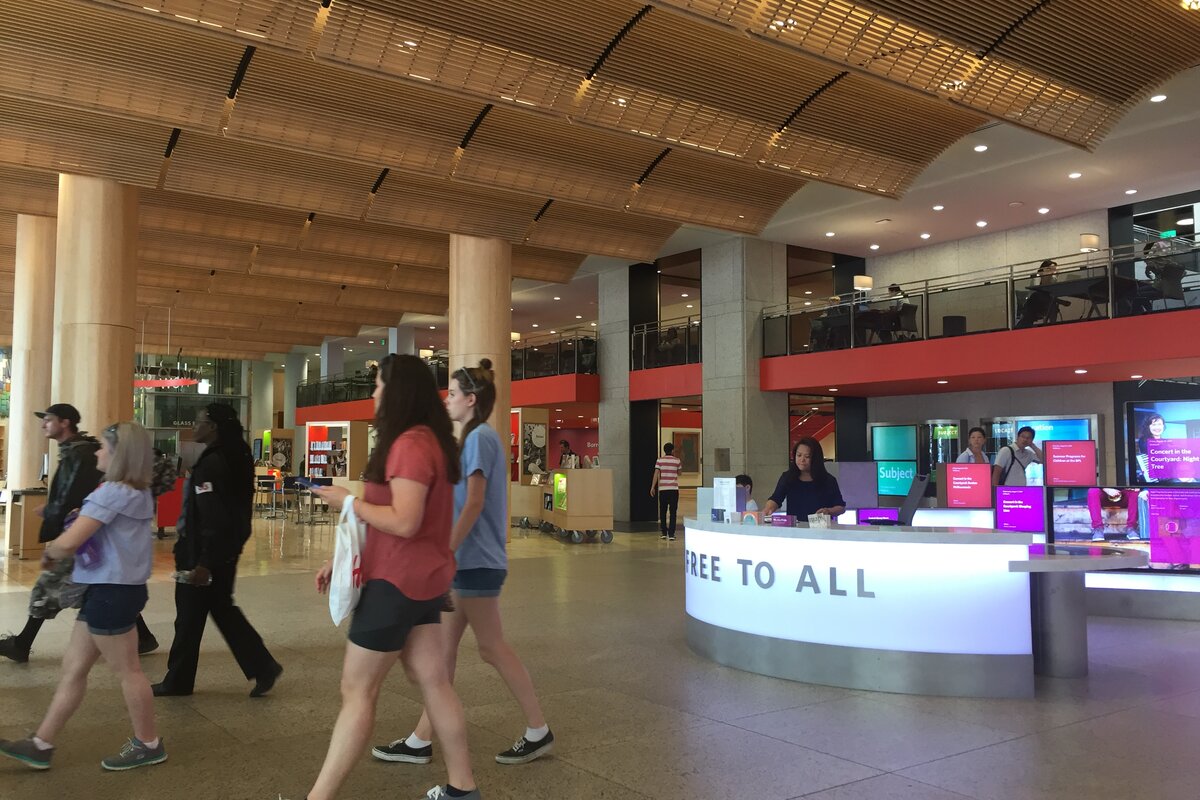Libraries obsolete? No way, say Millennials.
Loading...
Standing behind the front desk in her cream cardigan and thick horn-rimmed glasses, Priya Charry looks like everyone's childhood librarian. Except, of course, for her long purple fingernails and gold nose ring.
Ms. Charry, who is in her mid-20s, recently earned her master’s in library science and now works as a part-time librarian for various Boston Public Library (BPL) branches. Charry says “more and more” Millennials are interested in being librarians. And just as we need to rethink the stereotypical librarian, she says, we need to reimagine what libraries can do for young people.
“Before I started working in a library I would hang out in libraries all the time, just as a place where people are willing to have a conversation or make recommendations for me,” says Charry, in between helping patrons at Boston's South End branch. “One of the biggest values of the library, for all ages, is that it's a free place where you can be outside of your home and outside of work.”
In the age of Amazon's two-hour delivery and ubiquitous internet searches, libraries are seemingly obsolete institutions. Adding to their 21st-century woes, public libraries across the country face budget struggles: The US Institute of Museum and Library Services has cut funding in 37 states since 2011.
But according to a recent Pew Research study, 53 percent of Millennials (those ages 18-35) in the United States visited a library at least once in 2016, more than any other generation. Books are expensive, say Millennials. So why not take advantage of the library?
“The books I get at the library are exploratory,” says Olivia Haskell, a rising junior at Colgate University in Hamilton, N.Y., while perusing the religion section at Boston's Central Library in Copley Square. “I don’t have to commit to buying them.”
Millennials say they also appreciate libraries’ free community spaces and in-person programming – two resources that fill a void in today’s digital age. The ability of libraries to fill this niche, say visitors and employees, will spell their future success.
“The tools and technology have changed, but libraries have always been innovative in responding to the needs of the community,” says Jim Neal, president of the American Library Association (ALA).
Mr. Neal recently visited public libraries across the country and says that libraries from York, Pa., to Santa Fe, N.M., are seeing an influx of Millennial patrons and are adjusting their offerings accordingly. “Libraries are one the few organizations that operate in the public interest. They support people, and they do it in a very neutral, nonjudgmental way.”
'The university of the people'
On a given Monday, the Boston Public Library’s online events calendar advertises a variety of free programs aimed at young adults, from “Job Search and Resume Help” at Central, “English/Spanish Language Exchange” at the West End branch, a book club discussion on a new bestseller at the Charlestown branch, to a free concert at the East Boston branch. Charry says the South End community, especially young visitors, suggest programs for their branch using a cork board on the back wall.
To Charry, offering such programming is part of the library's mandate. “It's a responsibility to teach the things that we know already, as much as it is an opportunity to gather people’s opinions, bring them in, and have them grow.”
Millennials are entering the field of library science to answer this call. Kate Benson, director of graduate admission for the Simmons College library science program, says the average applicant age has fallen to 27 in recent years. The younger applicants “want to promote literacy and access to information,” says Ms. Benson. “They want to serve their community in that way.”
Libraries have always been “the university of the people,” says Neal, by supplying more than just books. In the 19th century, for example, immigrants sought out public libraries to learn English. And the Pennsylvania Avenue branch of the Baltimore library was one of the few public buildings to remain open during the violent riots that followed the death of Freddie Gray, a young black man who died at the hands of local police officers in 2015.
Anne Smart, who has worked as a librarian for BPL for almost three decades, says she has watched local branches become “community gathering places” that neighborhoods – especially young people – depend on. Recently, for example, a young woman came in to print off bills while a young man came in to work on his resume.
A new vision of library space
Boston’s Central Library was redesigned last year with these needs in mind, says BPL President David Leonard. The $78 million renovation, which included tearing out walls, adding more charging outlets, and simplifying book organization, has led to a 22 percent uptick in foot traffic, says Mr. Leonard, and many of the new visitors are Millennials.
“The library is one of the few remaining spaces in society that everybody feels they have ownership over,” says Leonard. “Everyone feels like they can come here and rub shoulders together or engage in conversation.”
Jihyun Kim, a middle school math teacher in her early 30s, says she visits libraries all the time – but she rarely checks out books.
“I just like the feeling the library gives me. It’s calm, clean, organized,” says Ms. Kim. “I can bring my work here or use it as a meeting place.”
While helping two young patrons with a book request, librarian Charry reflects on the evolution of the institution she works for. “I think more and more people now are realizing [the library] is not only an intellectual place,” she says, “but also a creative place to have fun and relax.”







